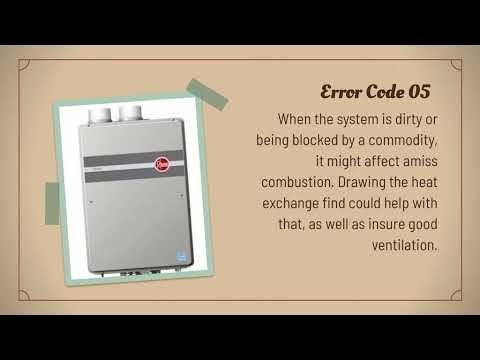
Picture this: it’s a chilly morning, and you’re all set for a warm shower to kickstart your day. As you turn on the faucet, expecting a comforting flow of hot water, you’re met with an unwelcome surprise—ice-cold water. Your trusty Rheem water heater displays the mysterious “E2” error code, leaving you puzzled. What could this cryptic message mean, and how can you fix it? Let’s unravel this mystery together.
Here’s the deal: your Rheem water heater is a sophisticated appliance, designed to provide you with a steady supply of hot water. However, sometimes it encounters a hiccup or two, displaying error codes like “E2” to communicate the issue. Although it might seem intimidating at first, understanding what this specific code means and how to resolve it doesn’t have to be complicated. Let’s dive into what the E2 error is all about and explore some practical solutions to get your water heater back in action.
Understanding the E2 Error Code on Your Rheem Water Heater
The E2 error code on a Rheem water heater typically indicates a problem with the thermistor. Now, you might be wondering, “What’s a thermistor?” In simple terms, a thermistor is a small sensor that measures the water temperature inside your heater. Think of it like a thermostat in your home, which regulates room temperature. Similarly, a thermistor helps the water heater maintain the desired water temperature.
So, when your water heater displays an E2 error, it means the thermistor isn’t working properly. It might be malfunctioning, not connected correctly, or even have a wiring issue. This could lead to inaccurate temperature readings, causing the appliance to either overheat or not heat the water at all. It’s essential to address this issue promptly, as neglecting it could lead to more significant problems down the line.
The good news is that you don’t need to be a tech wizard to tackle this issue. By understanding the basics of the E2 error code, you can take informed steps to resolve the problem or know when to call in a professional. Let’s explore the common causes and potential solutions to this error.
Common Causes of the E2 Error Code
Several factors could lead to the appearance of the E2 error code. One common culprit is a faulty thermistor itself. Over time, these sensors can wear out or become damaged due to regular usage or mineral buildup inside the water heater. Imagine driving a car with a faulty speedometer; you’d have trouble maintaining the correct speed, right? A malfunctioning thermistor is similar—it can’t gauge the water temperature accurately.
Another possible cause is a loose or disconnected wire. Just like a lamp won’t turn on if it’s unplugged, a thermistor can’t send the right signals if its connections are compromised. This could happen during maintenance or due to vibrations from daily use.
Lastly, electrical issues within the water heater can also trigger the E2 code. If the circuit board that processes the thermistor’s data malfunctions, it may misinterpret signals, leading to error messages. This is akin to a computer glitching out when it receives conflicting commands.
Steps to Resolve the E2 Error
Addressing the E2 error code involves a systematic approach. First, check the thermistor and its connections. For safety reasons, always turn off the power supply to your water heater before starting. Locate the thermistor, which is usually found near the thermostat, and inspect it for signs of damage. If you notice any wear or corrosion, it might be time to replace it.
Next, examine the wiring. Ensure all connections are secure, as loose wires could prevent the thermistor from functioning correctly. If you’re comfortable doing so, gently tighten any visible connections. However, if electrical work feels daunting, it’s better to call in a professional to avoid any risks.
Finally, consider resetting the water heater. Sometimes, just like rebooting a computer can resolve minor glitches, resetting your water heater might clear the error. Refer to your user manual for specific instructions on how to perform a reset. If the error persists after you’ve tried these steps, professional assistance may be needed to delve deeper into the appliance’s electrical components.
Preventing Future E2 Errors
While technical hitches can occur, there are measures you can take to reduce the chances of encountering the E2 error code again. Regular maintenance is key. Schedule periodic check-ups for your water heater to ensure components like the thermistor are in top-notch condition. This is similar to getting an oil change for your car—preventative care keeps everything running smoothly.
Moreover, consider installing a water softener if you live in an area with hard water. Mineral deposits from hard water can accumulate inside your heater, potentially damaging sensitive parts like the thermistor. A water softener helps reduce these deposits, extending the life of your appliance.
In conclusion, while the E2 error code might seem daunting at first, with a bit of knowledge and some straightforward troubleshooting steps, you can often resolve the issue without hassle. If all else fails, don’t hesitate to contact a professional for assistance. Keeping your water heater well-maintained and addressing any warnings promptly will ensure you enjoy hot showers without interruption.